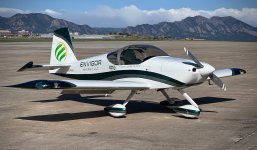Kevin49777
I'm New Here
I would like to hear from RV-14A owners on their takeoff and landing practices including how they conduct pattern work. I am close to flight testing my RV-14A and have gone for transition training with Van’s. After the transition training I am questioning if the takeoff and landing method taught by Van’s instructors is best for my intended use/mission. (Stable IFR cross country aircraft) Let me state up front that I am not questioning the professionalism, skill, knowledge, or experience of the instructors.
My questions:
1. With the excellent climb rate of the RV-14 for a VFR takeoff is 10+ degrees of pitch safer than lowering the nose a bit to have better forward visibility?
2. Is a continuous 30-degree bank turn from departure to crosswind-downwind so that the pattern is very tight and the end of the wing appears to touch the runway on downwind the best pattern size? At a controlled field, or with other aircraft in the mosquito size pattern seems to me to create separation problems and confuse controllers and other pilots.
3. When abeam the numbers on downwind is pitching for 75kts the best speed at this point in the pattern? Would say 80-90 not be better?
4. When 45 degrees from the numbers at 75kts initiating a 30 degree bank turn, is this not a bit steep in a slow flight configured aircraft?
5. When on the base/final 30 degree bank turn why a 1000+ fpm descent to the numbers? Would not a longer downwind, wider pattern, 20 degree military style turn rather than 30 degree military style turn, and a 300-500 fpm rate of descent to a landing past the numbers not be safer and result in many more “greased” landings?
I would appreciate any and all input from RV-14 owners.
My questions:
1. With the excellent climb rate of the RV-14 for a VFR takeoff is 10+ degrees of pitch safer than lowering the nose a bit to have better forward visibility?
2. Is a continuous 30-degree bank turn from departure to crosswind-downwind so that the pattern is very tight and the end of the wing appears to touch the runway on downwind the best pattern size? At a controlled field, or with other aircraft in the mosquito size pattern seems to me to create separation problems and confuse controllers and other pilots.
3. When abeam the numbers on downwind is pitching for 75kts the best speed at this point in the pattern? Would say 80-90 not be better?
4. When 45 degrees from the numbers at 75kts initiating a 30 degree bank turn, is this not a bit steep in a slow flight configured aircraft?
5. When on the base/final 30 degree bank turn why a 1000+ fpm descent to the numbers? Would not a longer downwind, wider pattern, 20 degree military style turn rather than 30 degree military style turn, and a 300-500 fpm rate of descent to a landing past the numbers not be safer and result in many more “greased” landings?
I would appreciate any and all input from RV-14 owners.





